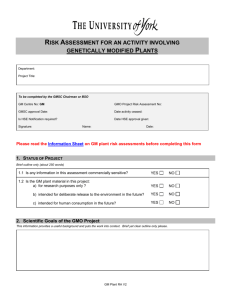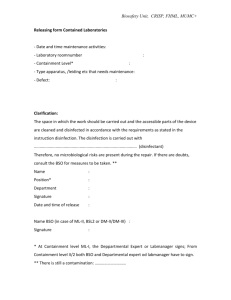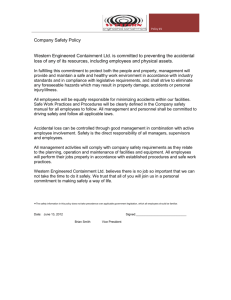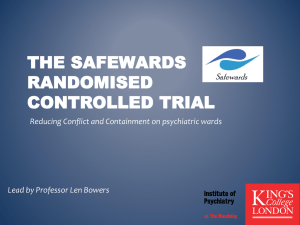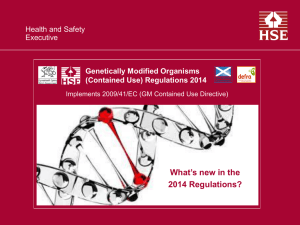GM Plant Risk Assessment - Queen`s University Belfast
advertisement
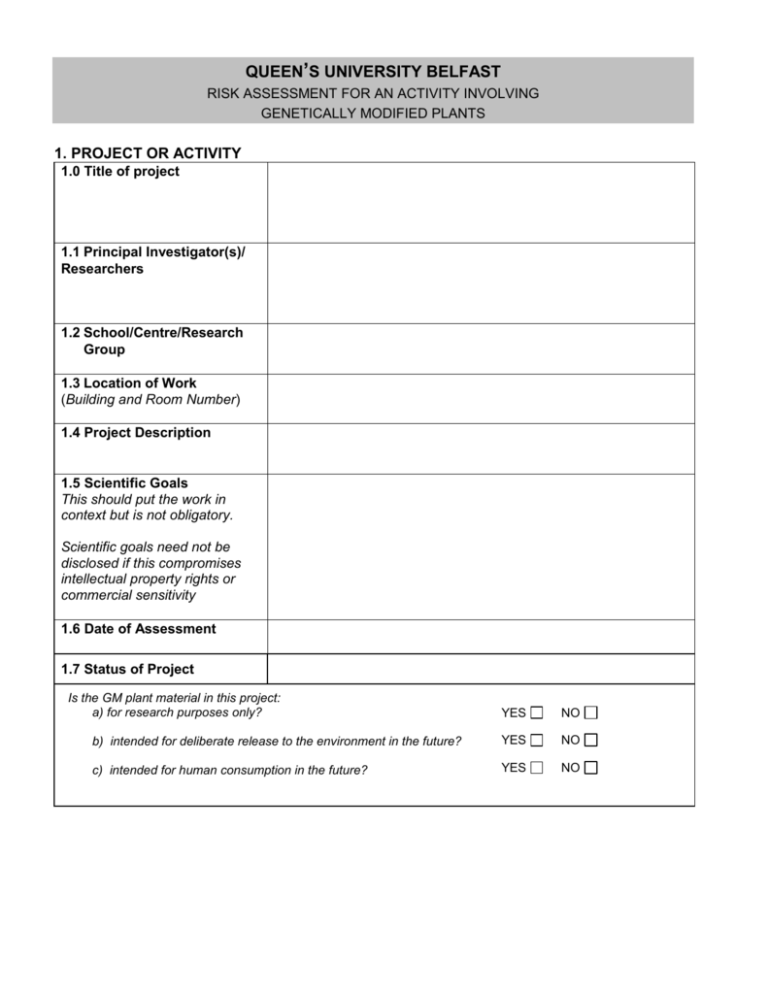
QUEEN’S UNIVERSITY BELFAST RISK ASSESSMENT FOR AN ACTIVITY INVOLVING GENETICALLY MODIFIED PLANTS 1. PROJECT OR ACTIVITY 1.0 Title of project 1.1 Principal Investigator(s)/ Researchers 1.2 School/Centre/Research Group 1.3 Location of Work (Building and Room Number) 1.4 Project Description 1.5 Scientific Goals This should put the work in context but is not obligatory. Scientific goals need not be disclosed if this compromises intellectual property rights or commercial sensitivity 1.6 Date of Assessment 1.7 Status of Project Is the GM plant material in this project: a) for research purposes only? YES NO b) intended for deliberate release to the environment in the future? YES NO c) intended for human consumption in the future? YES NO 2. SUMMARY AND CONCLUSIONS OF RISK ASSESSMENT What are the main risks to the environment or human health and how will these be controlled? Appendix 1 outlines the minimum control measures to be applied to all GM plant activities, designed to limit contact with the environment and humans, and appropriate for activities presenting a low/negligible risk? Will these measures be appropriate for your activity, or are further, more stringent measures required to prevent contact with the environment or humans? 3. DETAILS OF HOST/VECTOR AND INSERTED DNA/GENE HOST VECTOR INSERTED DNA/Gene 4. IDENTIFICATION OF POTENTIAL HARMFUL EFFECTS OF THE GM PLANT TO THE ENVIRONMENT 4.1 Hazard Identification Consider the following and identify any potential hazards by comparing the GM plant to the non-modified parent and assume the receiving environment will be exposed. a) Describe the GM plant’s ability to survive, establish and disseminate, compete with and / or displace other plants b) Describe the GM plant’s potential to cause harm to animals c) Describe the GM plant’s potential to cause harm to beneficial microorganisms d) Describe the GM plant’s potential to exhibit altered interactions with plant pathogens and the potential for harm that may arise e) Describe the GM plant’s potential to transfer genetic material to other organisms, thereby conferring any hazards identified in a) – d) on them List Hazards Identified in a) – e) 4.2 Assessment of Likelihood Assuming the recommended standard control measures(see Appendix 1) are to be used for the GM Plants, for each hazard identified, express the likelihood of a hazard being manifested as “ high”, “medium”, “low”, or “negligible”, giving justifications. 4.3 Assessment of Consequences For each hazard, describe the consequences to the receiving environment, assuming the receiving environment will be exposed. Express using the terms “severe”, “medium”, “low” or negligible” and give justifications. 4.4 Preliminary determination of risk to the environment For each hazard, identify the level of risk by combining the consequence (assuming exposure) with the likelihood (assuming use of the recommended standard control measures for GM Plants) using the matrix in the plant risk assessment guidance note. Express risk as “high”, “medium”, “low”, or “effectively zero”. 4.5 Containment measures to control the risk to the environment If the preliminary risk assessment in 5.4 is “low” or “effectively zero”, then standard control measures for GM Plants are appropriate. If the risk is “medium” or “high”, additional specific measures must be used. Describe the facilities and the containment measures required to control the hazards (e.g. if air filtration is required, specify the filtering efficiency). 4.6 Final determination of risk to the environment For each hazard, reassess the level of risk assuming that the measures in 5.5 are in place. The control measures should be such that the overall risk is “low” or “effectively zero”. 5. IDENTIFICATION OF POTENTIAL HARMFUL EFFECTS OF THE GM PLANT TO HUMAN HEALTH 5.1 Hazard Identification Consider the following and identify any potential hazards by comparing the GM plant to the non-modified parent and assume that humans will be exposed. a) Describe the GM plant’s potential to be more toxic to humans than the parent plant b) Describe the GM plant’s potential to be more allergenic to humans than the parent plant c) Describe the GM plant’s potential to exhibit other potential hazards to humans compared to the parent plant List Hazards Identified in a) – c) 5.2 Assessment of Likelihood Assuming the containment measures in 5.5 above, are in place, express the likelihood of a hazard being manifested as “ high”, “medium”, “low”, or “negligible”, giving justifications. 5.3 Assessment of Consequences For each hazard, describe the consequences, assuming that humans will be exposed. Express using the terms “severe”, “medium”, “low” or negligible” and give justifications. 5.4 Determination of risk human health For each hazard, identify the level of risk by combining the consequence (assuming exposure) with the likelihood (assuming measures listed in 5.5 are in place) using the matrix in the plant risk assessment guidance note. Express risk as “high”, “medium”, “low”, or “effectively zero”. 5.5 Containment measures to control the risk to human health If the risk in 6.4 is “low” or “ effectively zero”, then the containment measures in 5.5 are sufficient. If not, additional containment measures must be used to reduce the risk to risk “low” or “effectively zero”. Describe the proposed facilities and the containment measures and how this impacts on the determination of risk. 5.6 Final determination of risk to human health For each hazard, reassess the level of risk assuming that the measures in 6.5 are in place. The control measures should be such that the overall risk is “low” or “effectively zero”. 6. WASTE CONTROL MEASURES All waste potentially contaminated with GM plant material must be rendered non-viable prior to leaving the site for final disposal. 6.1 Is the SOLID GM waste autoclaved? Yes No If yes, where? a) Give the degree of ‘kill’ achieved Effectively 100% b) How has this been validated? Explain: If not, by how much? c) How will this be monitored on an ongoing basis? 7. NOTIFICATIONS Do the genetically modified plants have a greater degree of potential to cause harm to humans than the non-modified equivalent plant? Yes No If yes, the work must be notified to HSE. 8. OTHER LEGISLATION Is the activity subject to additional control by other legislation (such as DEFRA / DARD Plant Health Licence)? If so give details: 9. SUPPORTING REFERENCES List any references referred to in the risk assessment 10. NATURE OF WORK AND CONTROLS 10:1 Health Surveillance or Immunisation (If you need advice contact the University Occupational Health Service ) Will workers receive vaccinations/health surveillance? Should vaccine status be checked / boosted? YES / NO 10.2: Incompatible Medical Conditions Does the nature of the work preclude it being undertaken by workers with health problems that might make them more susceptible to infection or risk in pregnancy/breast feeding? 10:3 YES / NO Emergency Procedures Are sufficient emergency procedures in place and what are they? Reference may be made to relevant SOP’s and Risk Assessments relating to disinfection / decontamination. 10:4 Instruction, Training and Supervision Has sufficient and appropriate training been given to approve workers? YES / NO 11. ADDITIONAL MEASURES OVER AND ABOVE PROVISIONAL LEVEL OF CONTAINMENT 11.1: Additional Measures The containment measures outlined in Part II of Schedule 8 of the Contained Use Regulations will include some measures required where, and to the extent that the risk assessment shows they are required. However additional measures may be in any of the following circumstances: (i) To take full account of any properties of the GMM hazardous to human health (ii) To protect the environment (iii) To provide additional safeguards for particular work procedures 12. FINAL ASSIGNMENT OF CONTAINMENT MEASURES AND RISK CLASS 12.1: Aspects of the Project assigned to Class 1 12.2: Aspects of the Project assigned to Class 2 12.3: Aspects of the Project assigned to Class 3 Person Making Assessment Name: Position: Signed: Date: Please return completed form to: Dr David Norwood Biological Safety Officer University Safety Service 5a Lennoxvale Belfast BT9 5BY Tel 90974610 d.norwood@qub.ac.uk You will receive a response within 14 days of received application All risk assessments that require Class 2 containment or higher must be approved by the HSE (NI). This process may take up to 1 month. Work should not be commenced until this form has been reviewed by the GMSC and approved (if necessary) by HSE (NI). APPENDIX 1 Standard Control Measures for Containment of GM Plants The measures described below represent the minimum level of containment that should be used for GM plants presenting a low or negligible risk (determined by the risk assessment). The majority of modifications (e.g. with Arabidopsis thaliana) are unlikely to result in a more harmful phenotype, and these measures are considered reasonably practicable to limit contact with both humans and the environment to an acceptably low level. These can be adapted or supplemented with further detail specific to particular activities. GM Plants presenting a higher risk will require additional, more specific containment measures as identified in the risk assessment to ensure the risks to the environment or human health are adequately controlled. 1. General a) Plants must be contained within a structure (i.e. glass-house, plant growth room / cabinet, laboratory). b) Facilities should be maintained in a clean and tidy condition. Cleaning equipment (e.g. brooms, brushes) likely to become contaminated by seed should be labelled and designated for use in the containment facility only, and treated to remove or kill seeds before use elsewhere. c) Workers should apply good hygiene practices and wash hands before leaving a plant growth facilities. This is particularly important to control against the dissemination of GM seeds or pollen (see below). d) Laboratory coats must be worn for all work activities with GM Plants and removed on exiting the facility, and before washing hands. 2. Labelling of GM Material GM material and containment facilities should be clearly marked (labelled to indicate name of responsible person and group). Facilities should also be labelled with PHSI/DEFRA/DARD license number where appropriate. 3. Pollen Containment a) Remove flowers or stop experiments before the plant flowers if appropriate. b) Ventilated glasshouse compartments should have mesh fitted over the vents to prevent ingress of pollinating insects. c) Transfer of plants e.g. from growth rooms / glasshouses to laboratories should be carried out on trolleys. Plants should be covered using a) the metal trolley covers, b) propagator lids or, c) bags to minimise dispersal of pollen. d) Consider physical isolation and reproductive containment by bagging flower heads prior to anthesis using paper or glassine bags. Alternatively consider containment of plants within secondary insect or pollen proof containers. 4. Seed Containment a) In facilities where plants are grown to seed, measures should be taken to minimise the number of seeds that fall on the floor, e.g. bagging the flower heads and / or placing plant pots on large trays. b) Designated lab coats should be provided for exclusive use in the facility. c) For harvesting seed, seed heads should be collected in the growth facility, bagged and transferred to the laboratory. Seed should be recovered from the bags within trays which ensure containment of stray seeds. Stray seed should be collected by swabbing the trays and the swabs autoclaved. d) If plants are grown to seed, the risk of dispersal of the seed through any drainage system should be minimised. In the glasshouse run-off waste accumulates in channels in the concrete floors and runs into a collection vessel. The liquid is then filtered prior to disposal into the general drainage system. e) Transfer of plants e.g. from growth rooms / glasshouses to laboratories should be carried out on trolleys. Plants should be covered using a) the metal trolley covers, b) propagator lids or, c) bags to minimise dispersal of seed. f) Wash plant containers / pots in the designated sinks in the glasshouse facility (P Block) linked to the filtration system, and NOT in sinks in laboratory areas. 5. Waste Disposal Before disposal all plant material and growth media containing residual plant material must be autoclaved at 134ºC for 3 minutes. Seeds retained on filters should also be autoclaved before disposal. Other means of disposal may be used but must be validated to ensure killing of any plant material and explained in detail in the risk assessment.
